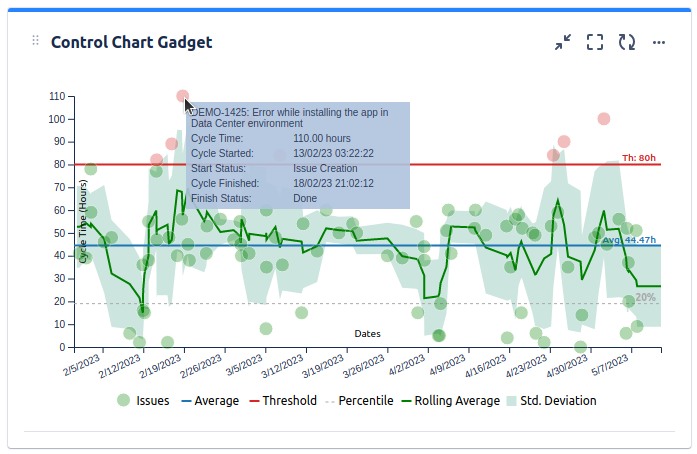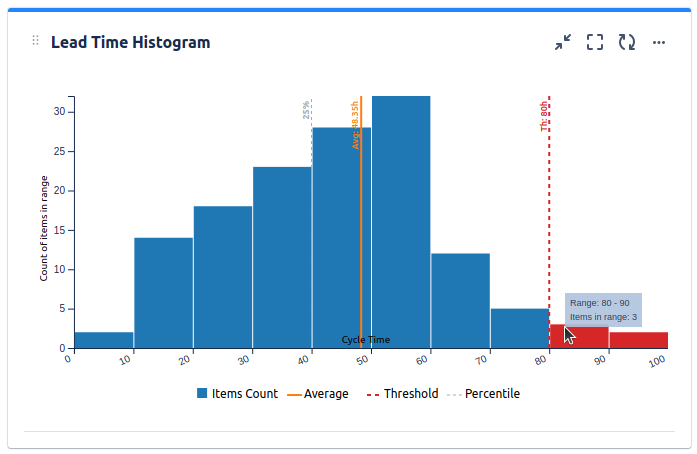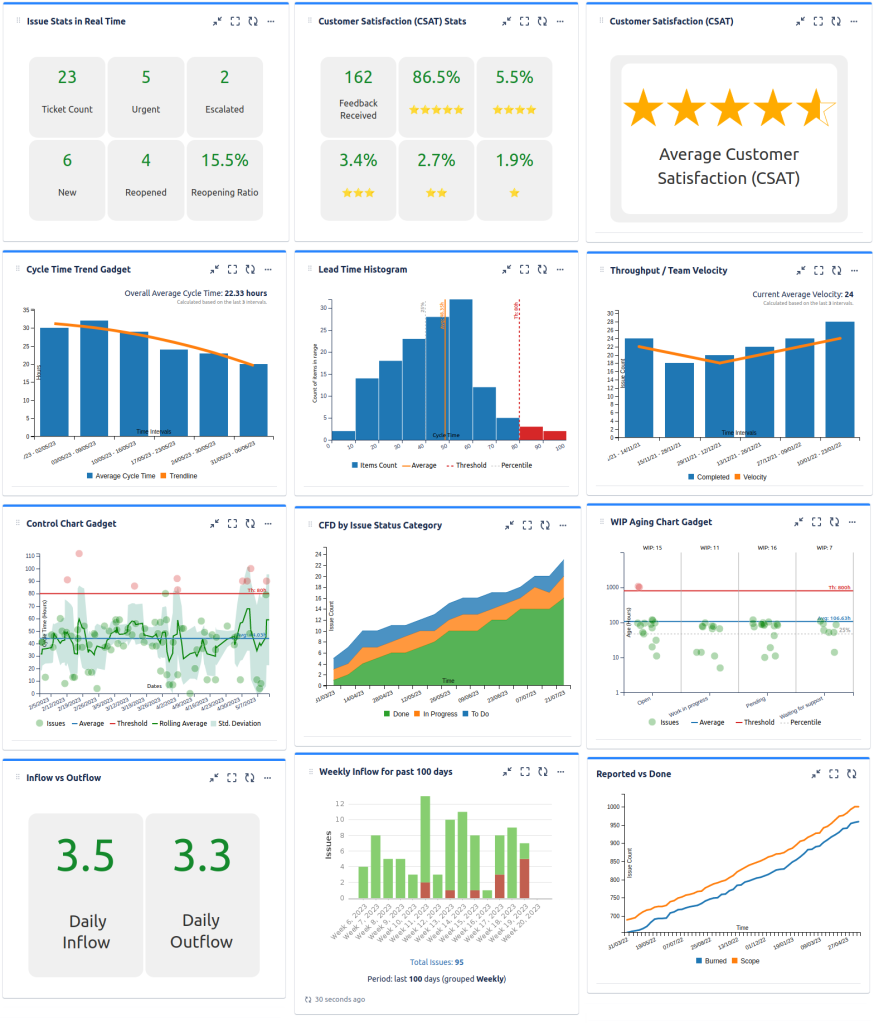Community resources
Community resources
Community resources
Display Average Lead & Cycle Time values in a dashboard
Hi!
We have recently introduced Lead Time and Cycle Time as new custom-fields in our system.
I'd like to know if it's possible to create a Dashboard panel with its default tools so that I can see how Average time evolves over time?
5 answers
1 accepted

First thing, I do not work for Atlassian or a marketplace vendor...I am just another user who also has attempted to implement such Lean measures with Jira tools. With that out of the way...
The built-in, Atlassian interpretation of a control chart does what you ask for a Jira board: https://support.atlassian.com/jira-software-cloud/docs/view-and-understand-the-control-chart/
Although that chart has several challenges, it can be helpful to both get started with the measures of Lead Time and various Cycle Times...and to manage / remove outliers.
If you want to see this (and more) information on a Jira dashboard instead, you will need to either:
- purchase marketplace addons
- use custom fields and automation rules to gather measures, and then view them with built-in and free dashboard gadget addons
Kind regards,
Bill
Hi Bill!
Thank you for your reply. We will try the control chart first. Although we have created the necessary custom fields and automation rules to measure them. But we still lack a tool to plot them in a chart.
You must be a registered user to add a comment. If you've already registered, sign in. Otherwise, register and sign in.

There are free, dashboard gadgets which may help to do that in the Atlassian marketplace. Those would need to be installed, so please check with your team / other site admins to see what they think about trying them.
https://marketplace.atlassian.com/search?hosting=cloud&moreFilters=free&product=jira&query=chart
I recommend creating your charts to learn what helps. That could be done with by hand (on paper / whiteboard), with free dashboard gadgets, exported data to a spreadsheet, or with the Google Sheets / Excel addins for Jira. After experimentation you may determine how to proceed, and perhaps investigate addons if more is needed.
You must be a registered user to add a comment. If you've already registered, sign in. Otherwise, register and sign in.
If you prefer to use a marketplace app, you can try Status Time Reports app developed by our team. It mainly provides reports and gadgets based on how much time passed in each status.
Here is the online demo link, you can see it in action and try without installing the app. For your case, you can have a look at Lead Time for Each Issue and Cycle Time for Each Issue reports. For further details, you can have a look at Cycle Time and Lead Time in Jira: Productivity Measurement with Two Critical Parameters article and Status Time Reports How to Videos.
- This app has a dynamic status grouping feature so that you can generate various valuable reports as time in status, time in assignee, status entry dates and status counts, cycle time and lead time, average/sum reports by any field(e.g. average in progress time by project, average cycle time by issue creation month).
- You can search issues by Project, Issue Type, Status, Assignee, Issue Creation/Resolution Date(and any other Date field) and JQL Query.
- Status durations are calculated according to the working calendar you define. Once you enter your working calendar into the app, it takes your working schedule into account too. That is, "In Progress" time of an issue opened on Friday at 5 PM and closed on Monday at 9 AM, will be a few hours rather than 3 days.
- You can set different duration formats.
- You can export reports in CSV file format and open them in MS Excel.
- You can also add this app as a gadget to your Jira dashboards and reach “Status Time” from Issue Detail page.
- You can enable/disable access to Status Time reports&gadgets and Issue Detail page per project, users, groups or project role.
If you are looking for a completely free solution, you can try the limited version Status Time Reports Free.
Hope it helps.
You must be a registered user to add a comment. If you've already registered, sign in. Otherwise, register and sign in.
Hi @Nacho Cortes 👋
Also, you can try alternative solution – Time in Status add-on. Gadget feature lets you monitor customized reports from the app on the Jira dashboard. All add-on reports are available in this gadget and you can control time in status data in the Issue List or Chart View.
One of report is Average Time
Hope it helps 😌
You must be a registered user to add a comment. If you've already registered, sign in. Otherwise, register and sign in.
Hello @Nacho Cortes ,
I understand that you are not looking for a paid solution right now. However, if you ever need it I can recommend Timepiece - Time in Status for Jira which is built by my team at OBSS. It is available for Jira Server, Cloud, and Data Center.
Time in Status mainly allows you to see how much time each issue spent on each status or each assignee.


You can combine the time for multiple statuses to get metrics like Issue Age, Cycle Time, Lead Time, Resolution Time etc.
For all numeric report types, you can calculate averages and sums of those durations grouped by the issue fields you select. For example total in-progress time per customer or average resolution time per sprint, week, month, issuetype, request type, etc. The ability to group by parts of dates (year, month, week, day, hour) or sprints is particularly useful here since it allows you to compare different time periods or see the trend.
The app calculates its reports using already existing Jira issue histories so when you install the app, you don't need to add anything to your issue workflows and you can get reports on your past issues as well.
Time in Status reports can be accessed through its own reporting page, dashboard gadgets, and issue view screen tabs. All these options can provide both calculated data tables and charts. And the app has a REST API so you can get the reports from Jira UI or via REST. Also you can export the reports in to various formats easily.
Visit Timepiece - Time in Status for Jira to explore how our JIRA add-on can revolutionize your metrics measurement process. Enjoy a 30-day free trial to experience the full range of features.
If you wish, you can also schedule a live demo. We will provide a comprehensive overview of the application and address any inquiries you may have.
Hope it helps,
Gizem
You must be a registered user to add a comment. If you've already registered, sign in. Otherwise, register and sign in.
Hi @Nacho Cortes,
You can easily do this with our Great Gadgets app.
It offers some gadgets for track Cycle Time and/or Lead Time in various ways. No need for custom fields; you define how to measure as time between workflow statuses.
Trend Chart - calculates and displays the cycle time / lead time for past time intervals along with the trend line to see if your team improves over time.

Control Chart - this displays the issues by their cycle time / lead time. You have the option to set a threshold, so that the chart can highlight the issues that took longer.

Histogram Chart - displays the issues by their cycle time / lead time, showing how many breached the SLA

These gadgets are based on Jira filters. All of them can also display a Data tab, showing the chart data, which you can easily export in CSV.

This app offers many other gadgets that you will find useful. Just have a look over our blog to make an idea.

It definitely can be a great asset for your team and your company.
Thank you,
Danut Manda
You must be a registered user to add a comment. If you've already registered, sign in. Otherwise, register and sign in.
Hi Danut!
I like to explore free/system default solutions until I find a barrier that prevents me from reaching my goal, then I consider buying.
Since we're in an exploration phase, we'll now follow Bill Sheoby's advice.
You must be a registered user to add a comment. If you've already registered, sign in. Otherwise, register and sign in.



You must be a registered user to add a comment. If you've already registered, sign in. Otherwise, register and sign in.